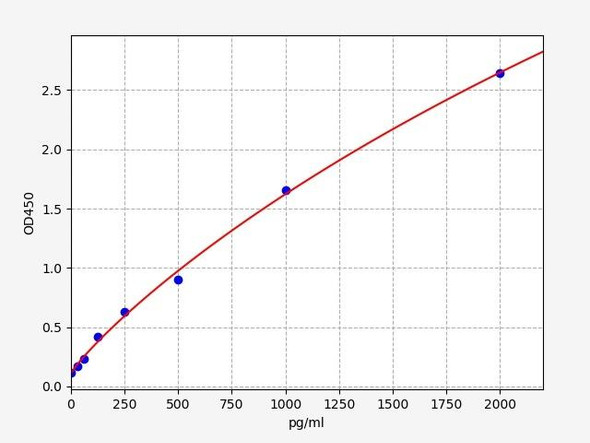Description
| Product Name: | Mouse S100-A6 Recombinant Protein |
| Product Code: | RPPB4561 |
| Size: | 20µg |
| Species: | Mouse |
| Target: | S100-A6 |
| Synonyms: | Protein S100-A6, S100 calcium-binding protein A6, Calcyclin, Prolactin receptor-associated protein, 5B10, S100a6, Cacy, 2A9, PRA. |
| Source: | Escherichia Coli |
| Physical Appearance: | Sterile Filtered clear solution. |
| Formulation: | S100A6 protein solution (0.5mg/ml) containing 20mM Tris-HCl buffer (pH 8.0), 1mM DTT, 30% glycerol and 100mM NaCl. |
| Stability: | Store at 4°C if entire vial will be used within 2-4 weeks. Store, frozen at -20°C for longer periods of time. For long term storage it is recommended to add a carrier protein (0.1% HSA or BSA).Avoid multiple freeze-thaw cycles. |
| Purity: | Greater than 95.0% as determined by SDS-PAGE. |
| Amino Acid Sequence: | MGSSHHHHHH SSGLVPRGSH MACPLDQAIG LLVAIFHKYS GKEGDKHTLS KKELKELIQK ELTIGSKLQD AEIARLMDDL DRNKDQEVNF QEYVAFLGAL ALIYNEALK |
S100A6 is a member of the S100 family of proteins containing 2 EF-hand calcium-binding motifs. S100 proteins are localized either in the cytoplasm or the nucleus of a wide range of cells. S100 proteins are involved in the regulation of a number of cellular processes such as cell cycle progression and differentiation. There are at least 13 members in the S100 gene family, which are located as a cluster on chromosome 1q21.S100A6 may function in stimulation prolactin secretion, and exocytosis. Chromosomal rearrangements and altered expression of the S100A6 gene are implicated in melanoma.
S100A6 produced in E.Coli is a single, non-glycosylated polypeptide chain containing 109 amino acids (1-89 a.a) and having a molecular mass of 12.2kDa.S100A6 is fused to a 20 amino acid His-tag at N-terminus & purified by proprietary chromatographic techniques.
| UniProt Protein Function: | S100A6: May function as calcium sensor and contribute to cellular calcium signaling (Potential). May function by interacting with other proteins and indirectly play a role in the reorganization of the actin cytoskeleton and in cell motility. Binds 2 calcium ions. Calcium binding is cooperative. Belongs to the S-100 family. |
| UniProt Protein Details: | Chromosomal Location of Human Ortholog: 3 F1|3 39.35 cM Cellular Component: cytoplasm; cytosol; extrinsic component of cytoplasmic side of plasma membrane; membrane; nuclear envelope; nucleus; perinuclear region of cytoplasm; plasma membrane; ruffle Molecular Function:calcium ion binding; calcium-dependent protein binding; ion transmembrane transporter activity; metal ion binding; protein binding; protein homodimerization activity; tropomyosin binding; zinc ion binding |
| UniProt Code: | P14069 |
| NCBI GenInfo Identifier: | 6755392 |
| NCBI Gene ID: | 20200 |
| NCBI Accession: | NP_035443.1 |
| UniProt Related Accession: | P14069 |
| Molecular Weight: | 10,051 Da |
| NCBI Full Name: | protein S100-A6 |
| NCBI Synonym Full Names: | S100 calcium binding protein A6 (calcyclin) |
| NCBI Official Symbol: | S100a6�� |
| NCBI Official Synonym Symbols: | 2A9; PRA; 5B10; Cacy; CALCYCLIN�� |
| NCBI Protein Information: | protein S100-A6 |
| UniProt Protein Name: | Protein S100-A6 |
| UniProt Synonym Protein Names: | 5B10; Calcyclin; Prolactin receptor-associated protein; S100 calcium-binding protein A6 |
| Protein Family: | Protein |
| UniProt Gene Name: | S100a6�� |









